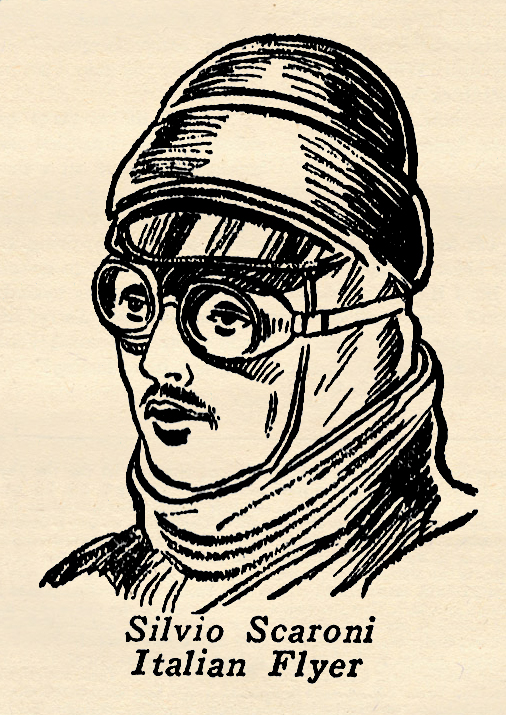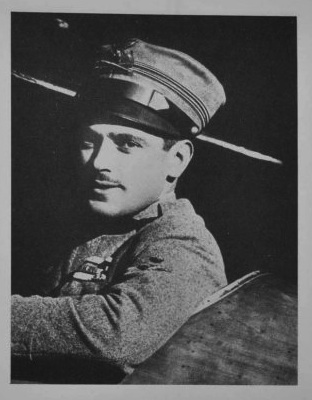Amidst all the great pulp thrills and features in Sky Fighters, they ran a true story feature collected by Ace Williams wherein famous War Aces would tell actual true accounts of thrilling moments in their fighting lives! This time we have Italian Fighter Ace Lieutenant Silvio Scaroni’s most thrilling sky fight!
Lieutenant Silvio Scaroni was  born at Brescia, Italy, and entered the aviation corps at the beginning of the war. As a bomber he was recognized as one of the best in the Italian Flying Corps and he was very adopt in handling big three-engined Capronis. But the big ships were too slow to satisfy Lieutenant Scaroni. He wanted to fly single Heaters and eventually managed to secure his transfer to a combat squadron on the morning of November 14, 1917.
born at Brescia, Italy, and entered the aviation corps at the beginning of the war. As a bomber he was recognized as one of the best in the Italian Flying Corps and he was very adopt in handling big three-engined Capronis. But the big ships were too slow to satisfy Lieutenant Scaroni. He wanted to fly single Heaters and eventually managed to secure his transfer to a combat squadron on the morning of November 14, 1917.
That same day he registered his first victory. Within three months he had accounted for 18 enemy planes. His untimely end came in an accidental crash. He was decorated with all the honors Italy could confer, and in Brescia a magnificent monument has been erected to his memory. His story, below is one of the most remarkable of all war experiences.
THE FLAMING COFFIN
by Lieut. Silvio Scaroni • Sky Fighters, August 1935
I HAVE had many dangerous moments in the air, in observation, bombardment and combat planes. But there is no doubt in my mind as to the most dangerous I ever experienced. It was that night over the Adriatic when I was flying a big three-engined Caproni as part of a bombing formation headed for the Austrian coast. Night flying enemy planes attacked us when we were utterly unprepared.
The brigadier out front had just called for me to come up and take the forward guns as we were approaching the coast line, when I heard a rattle, like rolling thunder, above the roar of the engines. Then there was what seemed like a flash of lightning and I felt myself spinning in the forward nacelle under the impetus of a terrific blow on my shoulder. I picked myself up from the floor of the pit and staggered erect. The big plane was diving straight down, and two lurid streams of fiery tracers splashed on the gangway.
The night attacker was less than fifty meters off our tail. I yelled to the brigadier to pull back on the wheel and yank the ship out of its dive. Then in the phosphorous glare of the tracer I saw that was not possible. The pilot was dead at the wheel, his head almost severed from his body. As I groped toward the control pit, I wondered why Captain Ercle, in the back gunner’s pit, had not come up to take over the controls. The ship was spinning violently and surging downward abruptly now. The Austrian pilot remained fastened to the falling ship like a leech, pumping hundreds of rounds into us. The other planes had disappeared in the blackness.
I managed finally to gain the pit. I stumbled over something and almost fell. When I looked down I saw why Captain Ercle had not been able to take over from the brigadier. It was his dead body I had stumbled over. I yanked the wheel from the dead brigadier’s hand, pushed him from the seat and got his feet off the rudder bar. It was only then I realized that I had only one good hand. My right hung limply at my side.
I gave the wheel a twist and ruddered against pressure, looking overside as I did so. There was a bare, rocky headland beneath, a small black shadow jutting into the sea. The bursts from the attacking plane were still clattering into the Caproni. One engine went dead, then another. I had only one left. Luckily it was the one in the rear, for I would never have been able to maneuver the plane if it had been one of the wing motors. I was weak.
With the rough rock just beneath, I dropped a landing flare. It hit the ground and exploded all at once, blinding me in its dazzling light. The ensuing darkness was blacker than Hades. I could see absolutely nothing, not even the glow lights on my instrument board. But I heard the wheels crunch. I pulled up swiftly, staggered crazily, bumped and rolled still.
Oncoming soldiers shouted at me to throw my hands up. I laughed in their faces and carefully set fire to the big plane. The rifle shots did not get me. Two weeks later I stole across the border and regained our own lines.









 born at Brescia, Italy, and entered the aviation corps at the beginning of the war. As a bomber he was recognized as one of the best in the Italian Flying Corps and he was very adopt in handling big three-engined Capronis. But the big ships were too slow to satisfy Lieutenant Scaroni. He wanted to fly single Heaters and eventually managed to secure his transfer to a combat squadron on the morning of November 14, 1917.
born at Brescia, Italy, and entered the aviation corps at the beginning of the war. As a bomber he was recognized as one of the best in the Italian Flying Corps and he was very adopt in handling big three-engined Capronis. But the big ships were too slow to satisfy Lieutenant Scaroni. He wanted to fly single Heaters and eventually managed to secure his transfer to a combat squadron on the morning of November 14, 1917. with 26 victories and an additional six unconfirmed! He is beat by the great Francesco Baracca who is credited with 34 victories, but Baracca did not survive the war. Scaroni did and went on to help establish a flying school for the Chinese Air Force at Loyang and set up an aircraft plant to produce Fiat fighters and Savoia-Marchetti bombers under license.
with 26 victories and an additional six unconfirmed! He is beat by the great Francesco Baracca who is credited with 34 victories, but Baracca did not survive the war. Scaroni did and went on to help establish a flying school for the Chinese Air Force at Loyang and set up an aircraft plant to produce Fiat fighters and Savoia-Marchetti bombers under license.